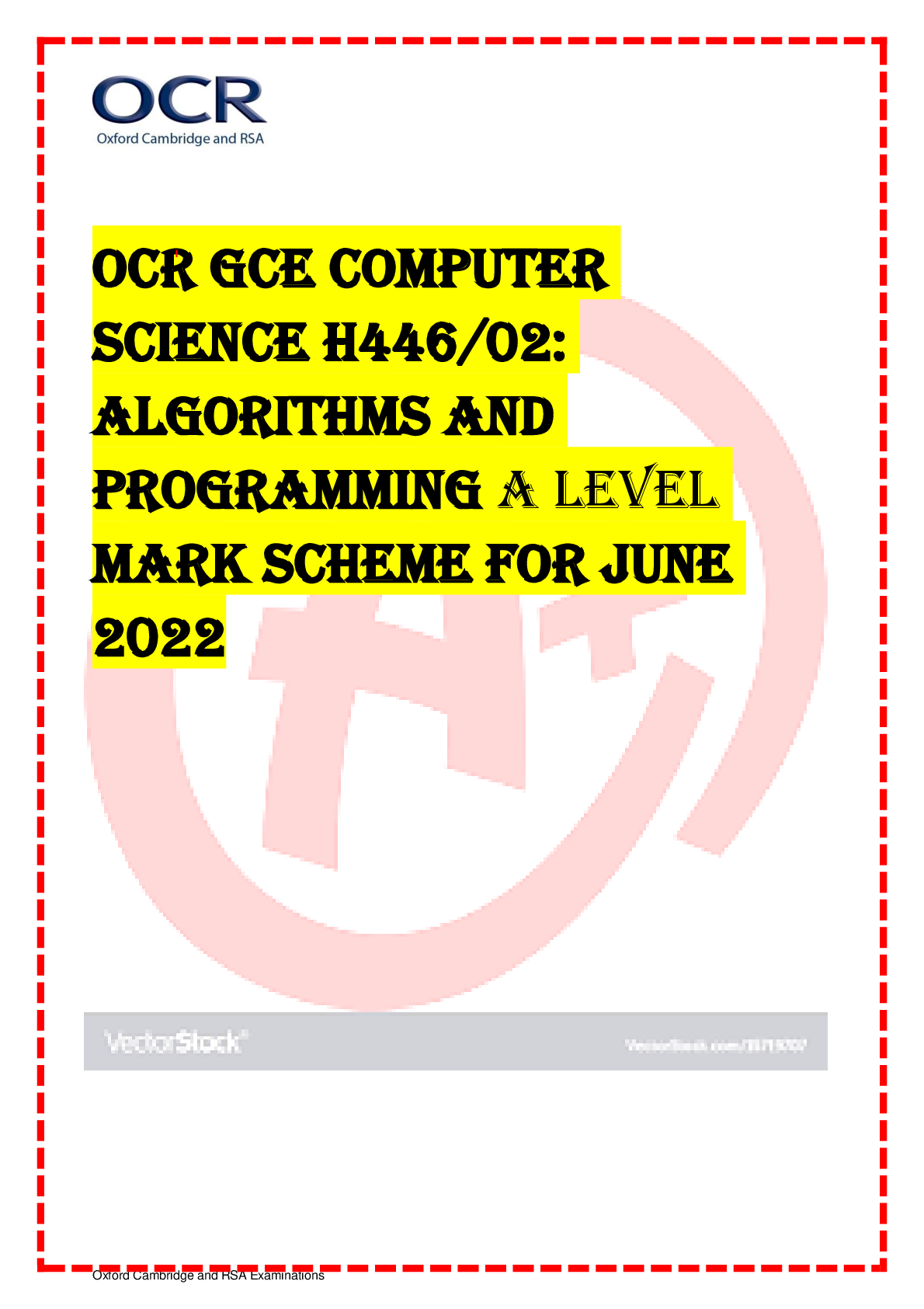Design and Technology > AS Mark Scheme > GCE Design and Technology H404/01: Principles of Design Engineering Advanced GCE Mark Scheme for Aut (All)
GCE Design and Technology H404/01: Principles of Design Engineering Advanced GCE Mark Scheme for Autumn 2021
Document Content and Description Below
Oxford Cambridge and RSA Examinations GCE Design and Technology H404/01: Principles of Design Engineering Advanced GCE Mark Scheme for Autumn 2021Oxford Cambridge and RSA Examinations OCR (Oxfor... d Cambridge and RSA) is a leading UK awarding body, providing a wide range of qualifications to meet the needs of candidates of all ages and abilities. OCR qualifications include AS/A Levels, Diplomas, GCSEs, Cambridge Nationals, Cambridge Technicals, Functional Skills, Key Skills, Entry Level qualifications, NVQs and vocational qualifications in areas such as IT, business, languages, teaching/training, administration and secretarial skills. It is also responsible for developing new specifications to meet national requirements and the needs of students and teachers. OCR is a not-for-profit organisation; any surplus made is invested back into the establishment to help towards the development of qualifications and support, which keep pace with the changing needs of today’s society. This mark scheme is published as an aid to teachers and students, to indicate the requirements of the examination. It shows the basis on which marks were awarded by examiners. It does not indicate the details of the discussions which took place at an examiners’ meeting before marking commenced. All examiners are instructed that alternative correct answers and unexpected approaches in candidates’ scripts must be given marks that fairly reflect the relevant knowledge and skills demonstrated. Mark schemes should be read in conjunction with the published question papers and the report on the examination. © OCR 20211. Annotations Annotation Meaning Blank Page – this annotation must be used on all blank pages within an answer booklet (structured or unstructured) and on each page of an additional object where there is no candidate response. Tick Cross Confused (replaces the question mark) Benefit of doubt AO1 – Knowledge and understanding AO2 – Apply knowledge and understanding AO3 - Analyse AO4 - Evaluation Omission Not answered question Noted but no credit given Too vague Own figure rule RepetitionH404/01 Mark Scheme October 2021 2.Subject Specific Marking Instructions INTRODUCTION Your first task as an Examiner is to become thoroughly familiar with the material on which the examination depends. This material includes: • the specification, especially the assessment objectives • the question paper • the mark scheme. You should ensure that you have copies of these materials. You should ensure also that you are familiar with the administrative procedures related to the marking process. These are set out in the OCR booklet Instructions for Examiners. If you are examining for the first time, please read carefully Appendix 5 Introduction to Script Marking: Notes for New Examiners. Please ask for help or guidance whenever you need it. Your first point of contact is your Team Leader.H404/01 Mark Scheme October 2021 Question Answer Mark Guidance 1 (a) (i) Possible ways my include: • The product can be used in the left or right hand (1). • The product has the bare minimum controls, just on/off and screw direction (1). • No labelling of controls is visible on the case, so there should be no language barriers (1). • Using it is intuitive – no instructions are required (1). • The product has been ergonomically designed to fit comfortably in one hand (1). • The illumination will help for users with non-perfect eyesight (1). • Any other valid suggestion. 2 In each case: One mark for identifying a way in which the electric screwdriver has been designed to be an inclusive and easy-to-use product. Specific reference to the context in the question is needed for marks to be awarded. (ii) Number of seconds in one year: One year = 60 x 60 x 24 x 365 = 31536000 s (1) Time to manufacture one unit: Time per unit = seconds in year / number of units Time per unit = 31536000* / 1000000 = 31.54 s (1) 2 Award two marks as follows: One mark for calculating the number of seconds in one year. One mark for calculating the average time in seconds to manufacture one screwdriver. If correct answer is given without working out shown award full marks. Where an incorrect answer is given working out should be used to credit appropriate marks. *Allow error carried forward (ECF) where correct working out is shown. (b) (i) Possible reasons may include: 4 In each case:H404/01 Mark Scheme October 2021 • A gearbox is needed to increase the torque output (1) because the torque direct from the motor is very small (1). • An epicyclic gearbox has a co-linear (in-line) input and output shaft (1) which enables the design of the electric screwdriver to be slim/compact (1). • Epicyclic gears can handle higher torque (1) because of their design, which is required in a screwdriver (1). • Epicyclic gearbox is compact (1) which leads to a smaller screwdriver design (1). • Any other valid suggestion. Up to two reasons for explaining why the designer chose to use an epicyclic gearbox in this application. Specific reference to the context in the question is needed for marks to be awarded. (ii) Combined gear ratio: GR = 7 x 7 = 49 (1) GR = input speed / output speed (non-maths mark) Therefore input (motor) speed: Rotational speed of motor = GR x output speed (1) = 49* x 215 = 10 535 rpm (1) 3 Award three marks as follows: One mark for calculating the combined gear ratio. One mark for recalling/manipulating the gear ratio formula (non-maths). One mark for calculating the rotational speed of the motor in the electric screwdriver. If correct answer is given without working out shown award full marks. Where an incorrect answer is given working out should be used to credit appropriate marks. *Allow error carried forward (ECF) where correct working out is shown.H404/01 Mark Scheme October 2021 (c) (i) Motor current = 1.25A (1) 1 (ii) V = IR (1) (non-maths mark) V = 2.5 x 0.1 Voltage = 0.25V (1) 2 Award two marks as follows: One mark for recalling the correct formula to calculate voltage. One mark for calculating the voltage across the 0.1Ω resistor when the motor current is 2.5A. (iii) Possible reasons may include: • It blocks direct current (1) while allowing alternating current to pass (1). • It stores electrical charges (1) and releases it as it is required by the circuit (1). • They can stabilise a power supply line (1) to prevent damage to components such as microprocessors (1). • They can be used to remove undesirable frequencies (1) by filtering interference such as radio frequencies. (1) • It can be sued to decouple one part of a circuit from another (1) to prevent noise in one part of the circuit affecting the rest of it (1). • Any other valid suggestion. 2 Up to two marks for explaining why a capacitor is used in electronic systems. Answers do not need to relate directly to the screwdriver application. (iv) For two marks: • 1st mark for stating that the amplifier will increase the voltage signal (1). • 2nd mark for stating that the signal is increased by a factor of 4 (1). 2 Up to two marks for describing the effect the amplifier will have on the voltage signal. Specific reference to the context in the question is needed for marks to be awarded. Only really one route available to access the two marks for this question.H404/01 Mark Scheme October 2021 (d) Indicative content: The candidate is expected to demonstrate their understanding of the process involved through a series of annotated sketches and/or notes. There may be variations to the process as indicated but to get into L3 candidates must demonstrate a clear understanding of the end to end process. Equipment: hand tools (saw, file, rasp, glasspaper, knife etc), hot wire cutter, CAD software and computer (3D design software, CAE software, 2D profile software combined with layering software), machines (drill, sander, router, CNC miller, 3D printer, laser-cutter), etc. Materials: polystyrene foam, polymorph, clay, casting resin, ABS/PLA filament for 3D printing, MDF, foam board, surface filler, paints etc. Processes: sculpting, filing, cutting, drilling, sanding, surface finishing and painting, 3D printing (with post processing of part), laser cutting (and explanation of how 3D model is created), description of how 3D CAD is used to create a part from a series of features, limitations of CNC machines, etc. Example of a Level 3 response: 6 All processes demonstrated must relate to the product in the question. Level 3 [5-6 marks] The candidate demonstrates a good level of detail of the process needed to make a nonfunctional model of an electric screwdriver using technical terms and considering any relevant equipment and materials. Sketches, if used will be clear and supported with relevant notes. The process includes all relevant stages. Level 2 [3-4 marks] The candidate will demonstrate a sound level of detail of the process needed to make a nonfunctional model of an electric screwdriver using some technical terms and there will be some consideration of any relevant equipment and/or materials. Sketches, if used, will for the most part be clear and supported with notes most of which are relevant. The process includes some relevant stages. Level 1 [1-2 marks] The candidate will demonstrate a limited level of detail of the process needed to make a nonfunctional model of an electric screwdriver with a limited use of technical terms and there will be a basic consideration of any relevant equipment and/or materials. Sketches, if used, willH404/01 Mark Scheme October 2021 be unclear with only basic notes to accompany them. Few relevant stages are included. 0 marks No response or no response worthy of credit. 2 (a) (i) Converting ¼ inch to mm: ¼ inch = 0.25 x 25.4 = 6.35 mm (1) The most suitable drill bit is 6 mm (1) 2 Award two marks as follows: One mark for converting the ¼ inch to mm. One mark for identifying the size of the most suitable drill bit to drill the hole.H404/01 Mark Scheme October 2021 (ii) The lower tolerance limit of the hole will be 95% of the specified value (1) The lower tolerance limit: Lower limit = 0.95 x 6.35 = 6.0325 mm (1) The 6 mm drill would not be within tolerance (1) Lower tolerance limit can also be calculated by: 6.35 – ((6.35/100) x 5) If part (i) is inaccurate but candidate states no (with no workings) award max 1 mark. 3 Award three marks as follows: One mark for determining that the lower tolerance limit of the hole will be 95% of the specified value. One mark for calculating the lower tolerance limit. One mark for determining that the 6 mm drill bit would not be within the tolerance. (b) (i) Probability of faulty gear = 80 / 5 000 Therefore probability (P) = 0.016 (1) 1 One mark for calculating the probability of a gear being faulty in the batch. Do not award a mark for an answer given as a fraction or as a percentage. (ii) No. of gears needed to find one faulty = 1/probability = 1 / 0.016* = 62.5 (1) Number of gears = 63 (1) 2 Award two marks as follows: One mark for dividing the calculated probability by 1. One mark for calculating the minimum number of gears which should be inspected if the probability of a faulty gear remains the same If correct answer is given without working out shown award full marks.H404/01 Mark Scheme October 2021 Where an incorrect answer is given working out should be used to credit appropriate marks. *Allow error carried forward (ECF) where correct working out is shown. (c) (i) Tan function to find the drop in height from start to end: Tan (2.5) = y / 30 (1) y = 30 x tan (2.5) = 1.31 m (rounded) (1) H = 2.8 – 1.31* = 1.5 m (1) 3 Award three marks as follows: One mark for recalling correct trigonometry formula (there could be more than one). One mark for calculating the distance y. One mark for calculating the height h in mm to 1 decimal place. If correct answer is given without working out shown award full marks. Where an incorrect answer is given working out should be used to credit appropriate marks. *Allow error carried forward (ECF) where correct working out is shown. 2.8m H 2.5° y 30mH404/01 Mark Scheme October 2021 (ii) Calculating the third angle in the triangle (A): Angle A = 180 – 66 – 69 = 45° (1) Using sine rule expression: 3/sin (A) = d/sin (66) Therefore: 3 / sin (45*) = d / sin (66) (1) Rearrange formula to find d: d = 3 x sin (66) / sin (45*) (1) Candidates may also write this as: d = (3/sin (45*)) x sin (66) Therefore: d = 3.88 m (1) 4 Award four marks as follows: One mark for calculating the third angle in the triangle. One mark for applying the correct trigonometry formula. One mark for rearranging the formula to find D. One mark for calculating the distance D in mm to 2 decimal places. If correct answer is given without working out shown award full marks. Where an incorrect answer is given working out should be used to credit appropriate marks. *Allow error carried forward (ECF) where correct working out is shown. A 69° 3m 66° dH404/01 Mark Scheme October 2021 (iii) Probability of zero failure = 1 – (1/25 000) = 0.99996 (1) No of days in use over 25 years = 300 x 25 = 7500 (1) Probability of zero failures = 0.99996*7500* = 0.74 (2 dec places) (1) Probability of failure over a 25 year period = 1-0.74* = 0.26 = 26% (1) 4 Award four marks as follows: One mark for calculating the probability of failure. One mark for calculating the number of days in use over a 25 year period. One mark for calculating the probability of zero failures. One mark for calculating the probability of failure as a percentage over a 25 year period. If correct answer is given without working out shown award full marks. Where an incorrect answer is given working out should be used to credit appropriate marks. *Allow error carried forward (ECF) where correct working out is shown. 3 (a) (i) Possible design features may include: • The LED bulb has the same screw fitting as the incandescent bulb (1). • The light output of the LED bulb has been made to almost match that of the incandescent bulb (1). • The dimensions/shape are/is the same (1). • Any other valid suggestion. 2 In each case: One mark for identifying a design feature of the LED bulb that has been influenced by the style and function of the incandescent bulb.H404/01 Mark Scheme October 2021 Specific reference to the context in the question is needed for marks to be awarded. (ii)* Indicative content: Impact on industry • Investment in new equipment and machinery • Investment in retraining workers in new manufacturing processes • New testing procedures • Searching for new suppliers of materials and components • New technology to learn • Health and safety implications/risk assessments • Review of profits, sales targets • New marketing strategy • New ventures, new opportunities for capitalists Impact on the lifestyle of users • New, unfamiliar technology • Costs of replacing bulbs • Concerns over the quality of the light from an LED bulb • Lower running costs, lower electricity bills • Lower costs mean than users can have more lights on at once, changing the ambience in the house • Less replacing of bulbs as LEDs last longer • Better security/safety because outside lights can be left on all night (including streetlamps) • Ability to integrate into smart house systems Impact on the environment • Lower power consumption means less fuel used, so lower carbon footprint, lower emissions • Bulbs last longer so less use of raw materials and less waste produced • Questions about recyclability of LED bulbs as they are more complex and contain multiple components • Questions about RoHS in LED bulbs • More lights left on at night causes light pollution 8 If candidate does not provide an analytical/evaluative response then only L1 can be awarded. Level 3 [6-8 marks] The candidate has a clear understanding of impact of changing from the stated product to another. They produce a thorough discussion in relation to the question by explaining the impact of changing from incandescent light bulbs to LED light bulbs. The explanation of impacts is clear and well developed and all three contexts provided within the question are covered. There is a well-developed line of reasoning which is clear and logically structured. The information presented is relevant and substantiated with the use of examples. Level 2 [3-5 marks] The candidate has a reasonable understanding of the impact of changing from the stated product to another. They produce a sound discussion in relation to the question by explaining the impact of changing from incandescent light bulbs to LED light bulbs. The explanation of impacts is sufficient although one or twoH404/01 Mark Scheme October 2021 Any other valid response. Example Level 3 response: opportunities are missed in providing different perspectives. At least two contexts provided within the question are covered. There is a line of reasoning presented with some structure. The information presented is for the most part relevant and supported by some evidence. Level 1 [1-2 marks] The candidate has a basic knowledge of the impact of product change. Any reference to the impact of changing from incandescent light bulbs to LED light bulbs is largely descriptive in nature. The response contains no analysis or evaluation. Only one context provided within the question is likely to be covered. The information has some relevance and is presented with limited structure or detail. The information is supported by limited evidence. 0 marks No response or no response worthy of credit.H404/01 Mark Scheme October 2021 (b) Possible methods may include: • Use celebrity endorsement (1) as part of an advertising campaign (1). • Incremental innovation (1) over the life of the product, increasing demand as popular new features are added (1). • A change of branding, image and logo (1) can attract a new target market and increase demand (1) • Release of product upgrades and add-ons (1) can extend the life of a product and maintain demand (1). • Any other valid suggestion. 4 In each case: Up to two marks for describing a method that could be used to create more demand and maintain a longer product popularity. This question is in no particular context so generic responses are fine.H404/01 Mark Scheme October 2021 4 (a) Possible properties may include: • They have a high impact resistance to withstand knocks and bangs on the cool box (1). • They have a low thermal conductivity which helps to insulate the contents inside (1). • They soften and become plastic when heated which means they can be moulded and formed into complex shapes (1). • Durability so the cool box can withstand scrapes and wear (1). • Resistant to corrosion so surface will stay clean and hygienic (1). • Good strength to weight ratio so the box will not be too heavy (1). • Any other valid suggestion. 2 In each case: One mark for identifying a property of thermo polymer softeners which make them suitable for the manufacture of parts in an electrically powered cool box. Specific reference to the context in the question is needed for marks to be awarded. The property must be qualified to gain the mark. i.e. low thermal conductivity on its own isn’t enough. (b) (i) Possible responses may include: • Electrical wires (1) • Screws (1) • Heatsink (1) • Magnets in motor (1) • Printed circuit board (1) • Any other valid suggestion. 1 One mark for identifying a part in an electrically powered cool box that would be made from metal. (ii) Possible responses may include: • If wires – copper (1) good electrical conductivity (1) • If screws – steel (1) hard/strong/machinable (1) • If heatsink – aluminium (1) good thermal conductivity (1) • If magnets in motor – neodymium (1) very strong magnetic properties (in alloy form) (1) • If PCB – copper (1) good electrical conductivity (1) • Any other valid suggestion. 2 One mark for stating a metal that would be used to manufacture the part of the electrically powered cool box identified. One mark for identifying a property of the metal that makes it suitable for use.H404/01 Mark Scheme October 2021 (c) Possible ways may include: • Use product labels (1) which will provide a clear indication to the consumer what action should be taken with product at end of its life (1). • Look at ways of incentivising consumer to take action (1) for example providing a product trade-in exchange for a new product (1). • Design for disassembly, incorporating modular design and semi-permanent joints (1) to increase the ease with which disassembly can be undertaken (1). • Label individual parts (1) to aid with dismantling and recycling (1). • Product take-back schemes (1) enable consumers to exchange old products for new products (1). • Any other valid suggestion. 4 In each case: Up to two marks for explaining what action a manufacturer can take to ensure that products, such as the electrically powered cool box, can be successfully recovered and effectively processed when they reach the end of their life. Answer can be given in or out of context here. (d) (i) Possible responses may include: • The cross ribs reduce the volume of polymer needed to manufacture the handle (1) whilst maintaining structural rigidity (1). This makes the handle cheaper to manufacture (1) and lighter weight (1). • The handle is flared out in the middle (1), and the cross ribs at this point provide a hand grip feature (1). The triangulation within the handle provides a texture that can be gripped firmly (1) to aid with carrying (1). • The cross ribs reduce the volume of polymer needed to manufacture the handle (1) whilst maintaining structural rigidity (1). Using less material for the handle reduces environmental impact (1) from excessive use of polymers (1). • The cross ribs stiffen the handle (1) so that it is less likely to bend when a heavy box is carried (1). The visible cross rib structure (1) enhances the aesthetics of the design (1). • Any other valid suggestion. 4 Up to four marks for describing how the performance of the handle is enhanced by its design. Specific reference to the context in the question is needed for marks to be awarded.H404/01 Mark Scheme October 2021 (ii) Example responses: 2 One mark for a sketch showing a valid mode of failure of the handle. One mark for marking the forces acting on the handle. There is only one way of accessing the two marks here although other modes of failure may be shown. (e) (i) One mark for formula recall: I = P/V (1) (non-maths mark) I = 42 / 12 I = 3.5A (1) 2 Award two marks as follows: One mark for recalling the correct formula to calculate the current (non-maths). One mark for calculating the current in amps when the cool box is plugged into a 12V supply. Weight Weight Handle breaks here Lift forceH404/01 Mark Scheme October 2021 (ii) Example full-mark response: 6 For full marks it will be clear that both internal and external temperatures will need measuring, and there will be some indication that time will be needed for the system temperature to stabilise. There may be an understanding that the test should be carried out over a range of external temperatures. Level 3 [5-6 marks]: A valid and rigorous test is described to evaluate whether the cool box can maintain a temperature 18° below external temperature. Valid equipment is identified (including a thermometer (temperature probe)), the method is clear and logically structured, and it is clear how the results would be used to reach a conclusion. Level 2 [3-4 marks]: A valid test is described to evaluate whether the cool box can maintain a temperature 18° below external temperature. Equipment is identified (including a thermometer (temperature probe)), the method is reasonable clear, and there is an attempt to explain how the results would be used to reach a conclusion. Level 1 [1-2 marks] A test is described to measure the temperature inside the cool box. Some equipment is identified, and there is some attempt to describe a method. There may be no indication of how the results would lead to a conclusion. 0 marks No response or no response worthy of credit.H404/01 Mark Scheme October 2021 Example Level 3 responses:OCR (Oxford Cambridge and RSA Examinations) The Triangle Building Shaftesbury Road Cambridge CB2 8EA [Show More]
Last updated: 1 year ago
Preview 1 out of 22 pages

Reviews( 0 )
Document information
Connected school, study & course
About the document
Uploaded On
Oct 10, 2022
Number of pages
22
Written in
Additional information
This document has been written for:
Uploaded
Oct 10, 2022
Downloads
0
Views
87








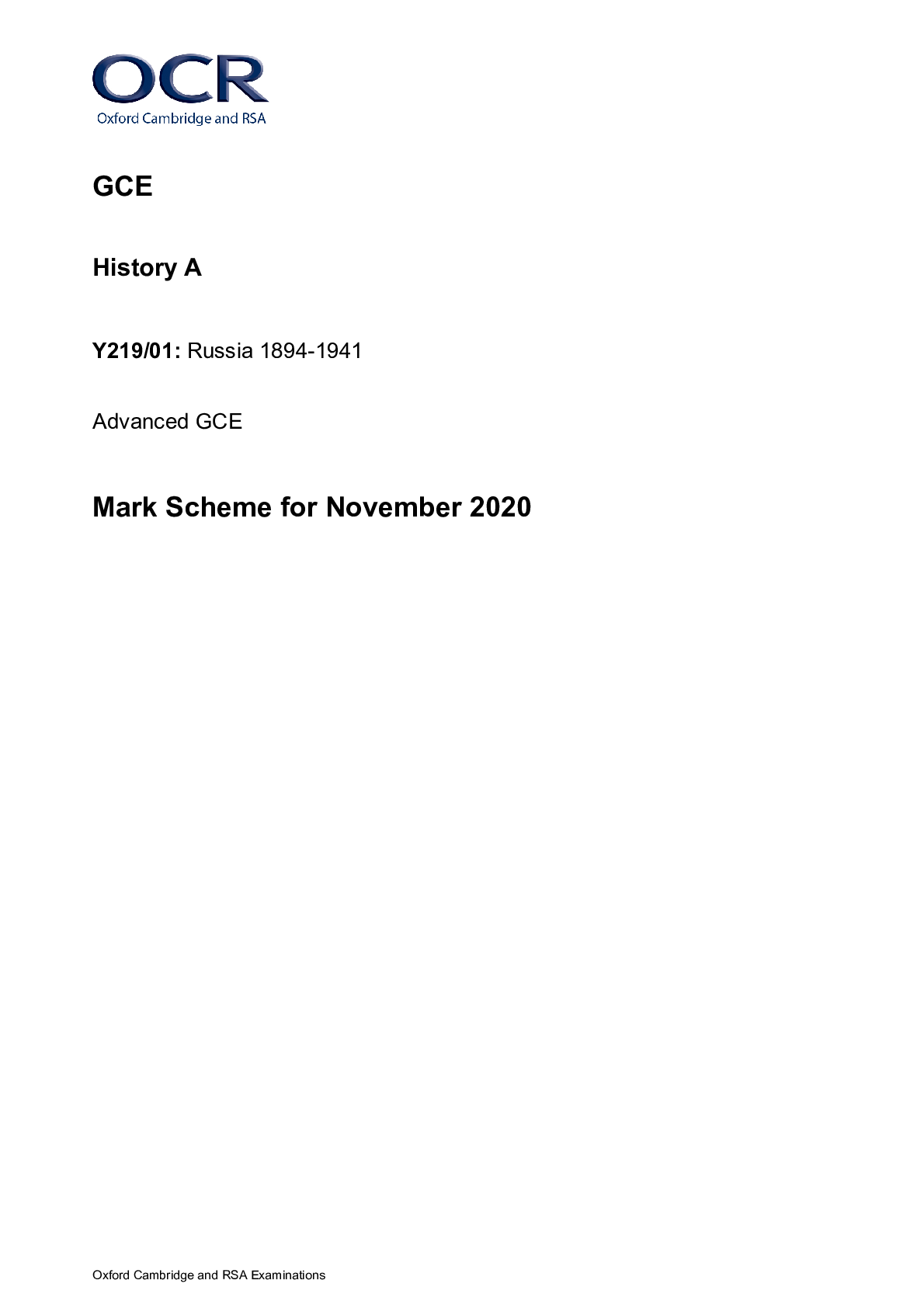
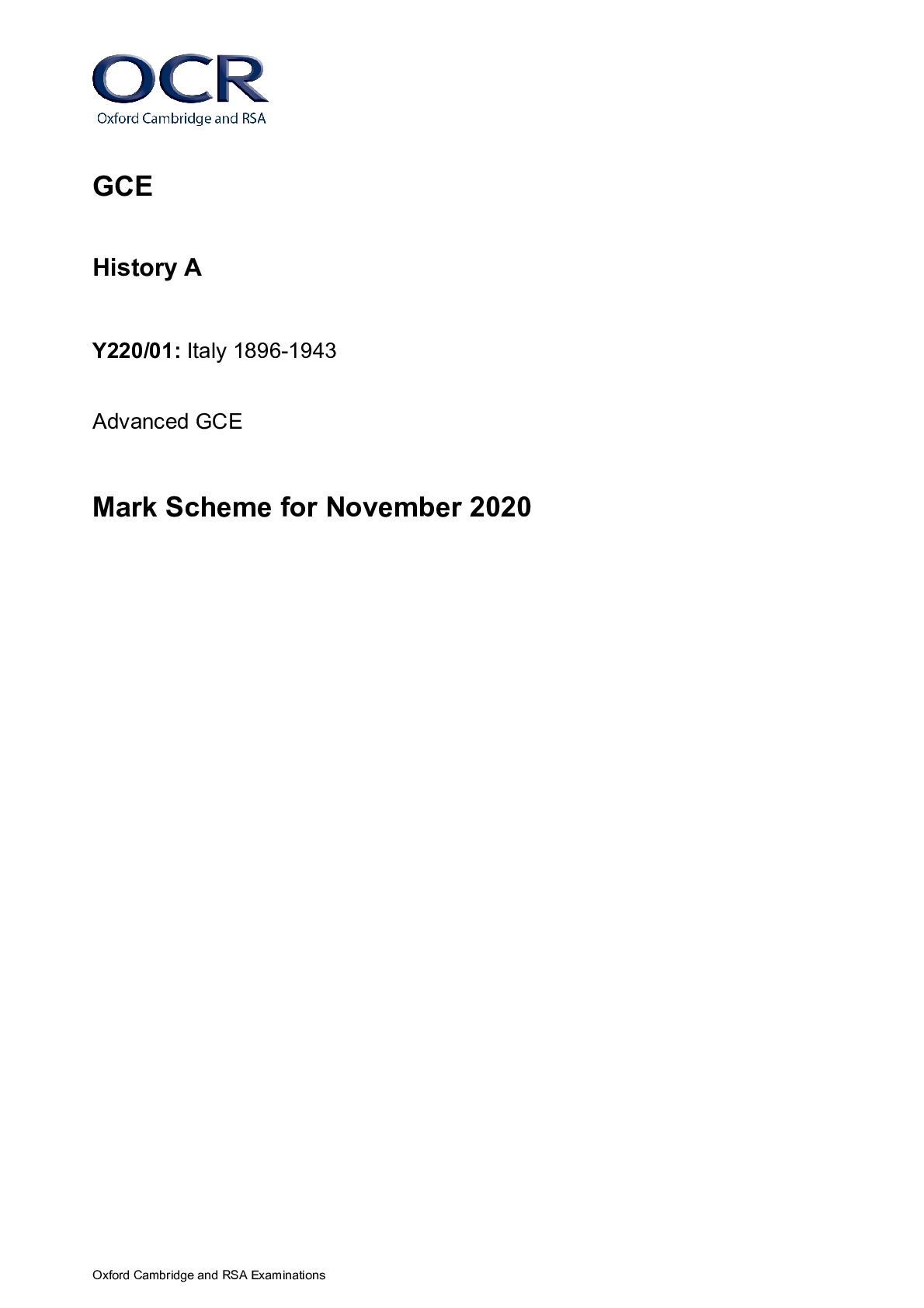

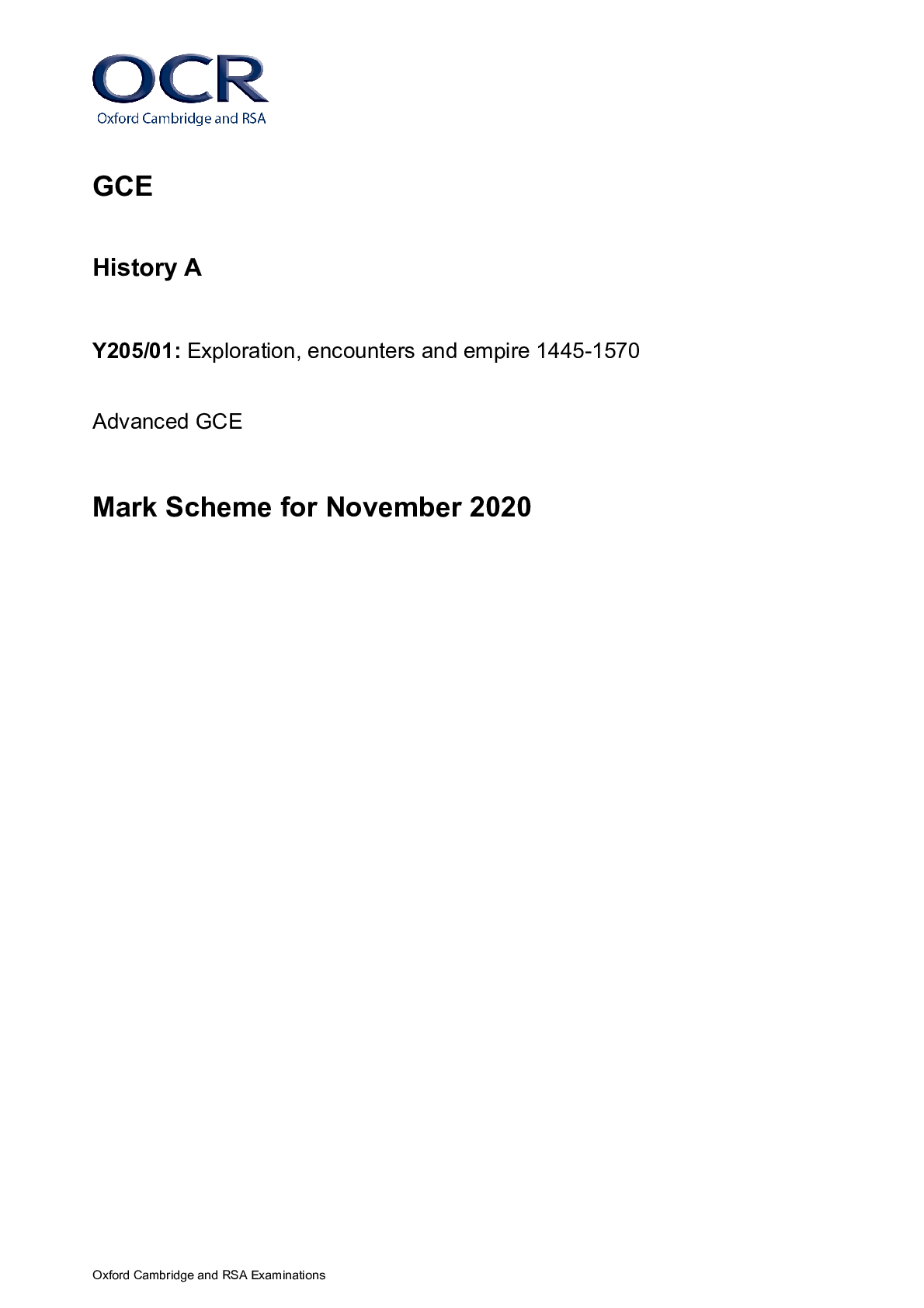
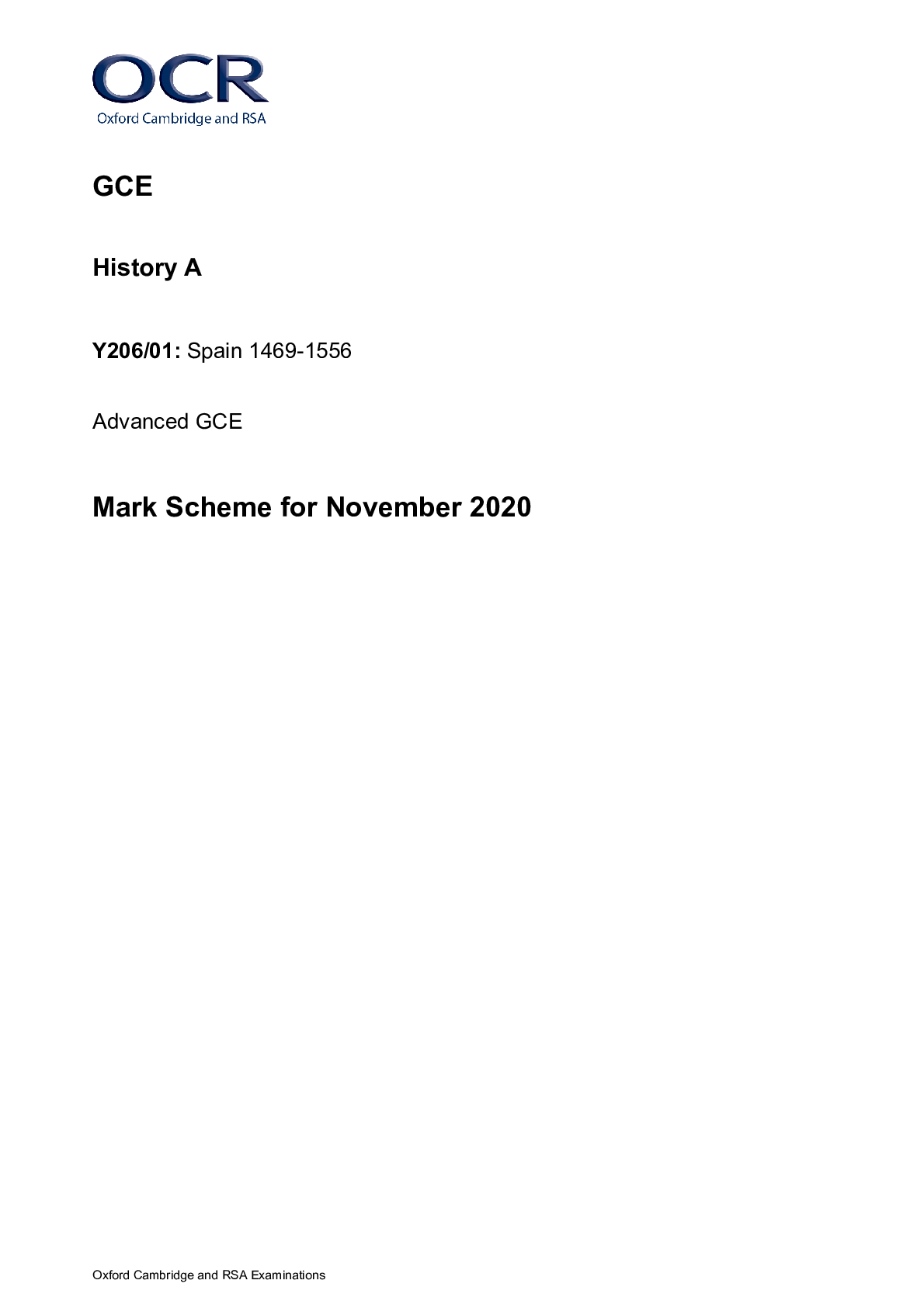
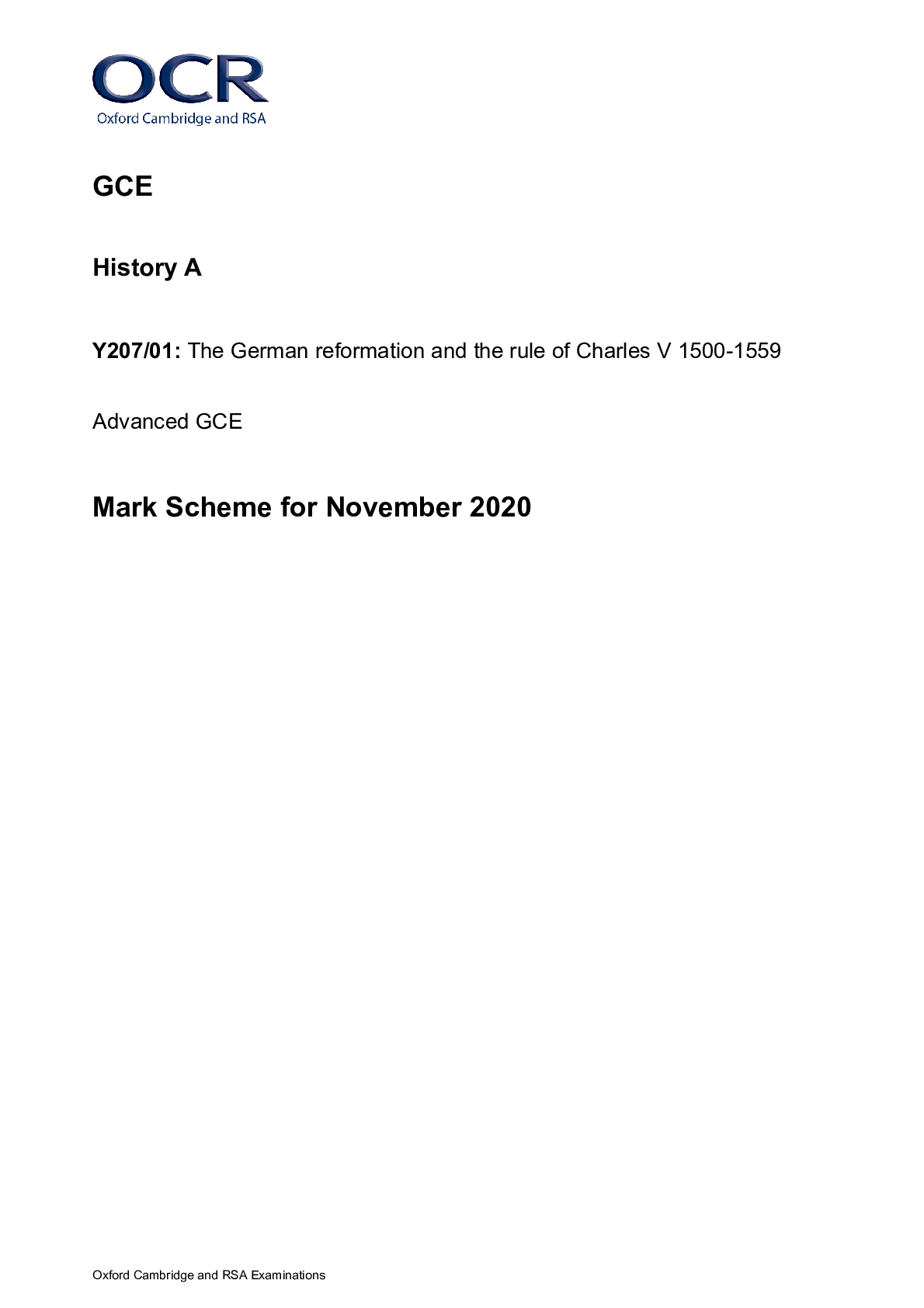
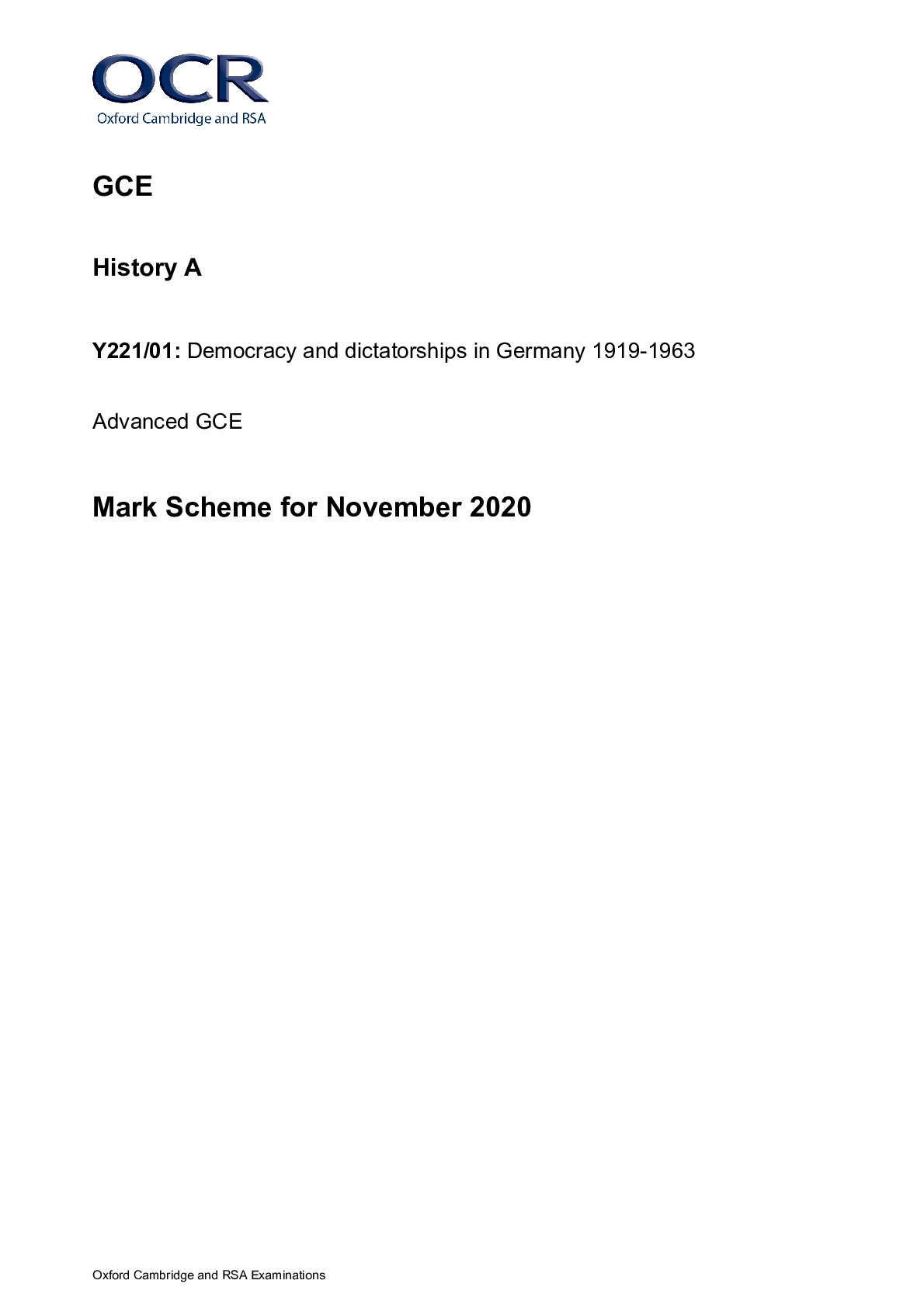

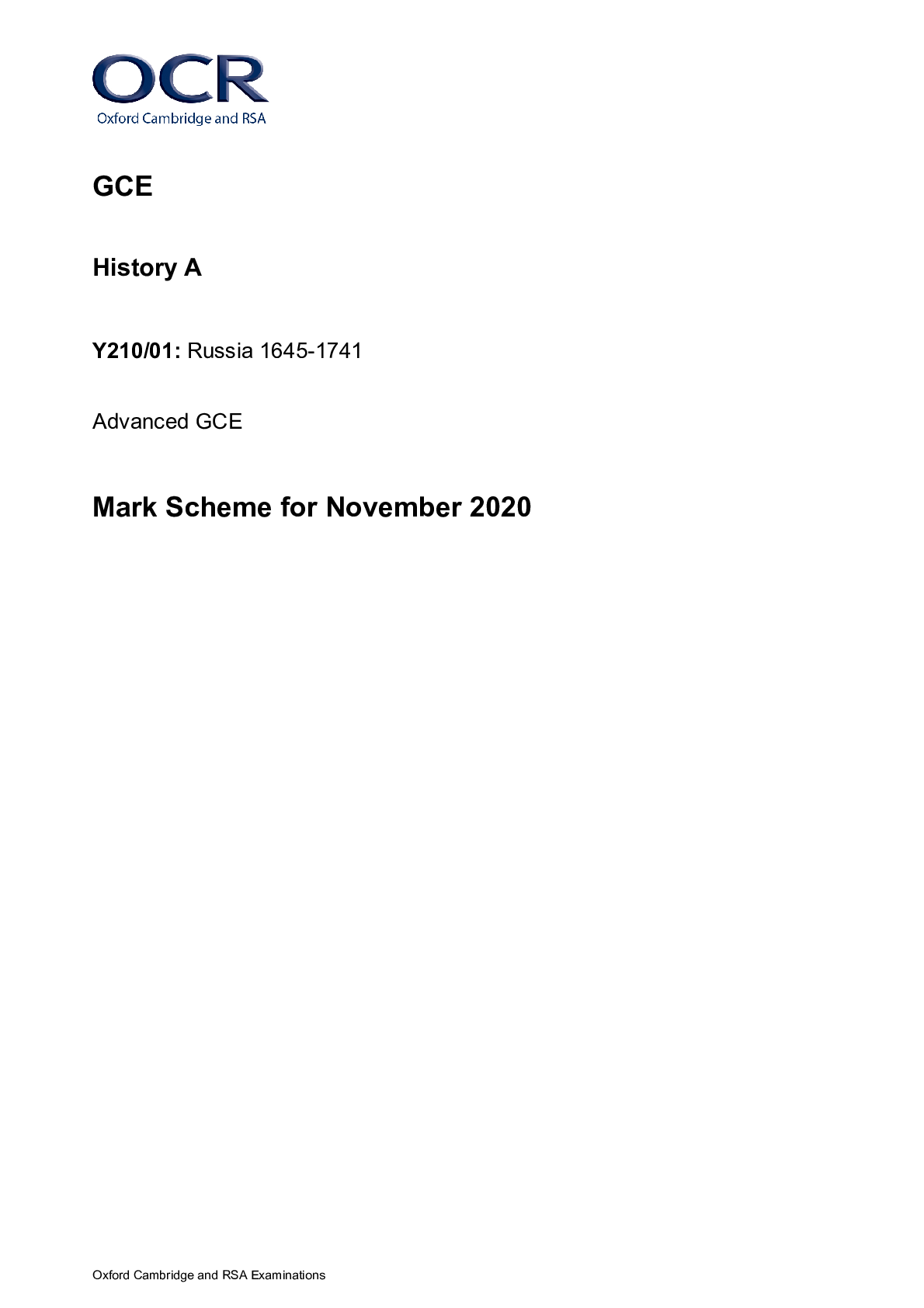


.png)



